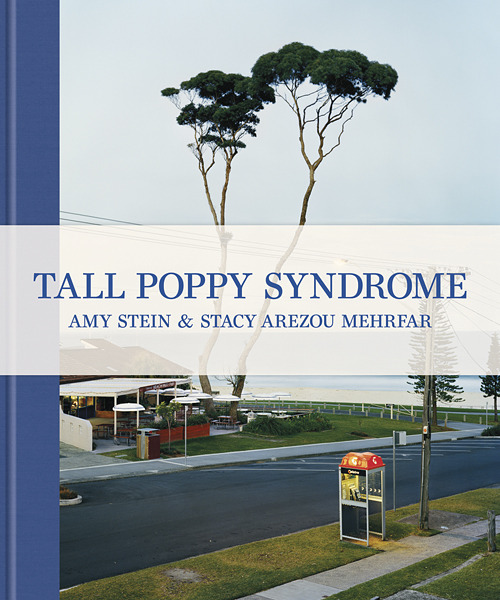
First off Stacy, this new project, 'Tall Poppy Syndrome' is a collaborative series you made in Australia with Amy Stein. How did this collaboration begin, and what drew the two of you to make this project?
Stacy Mehrfar (SM): In 2009 Amy and I met for a beer at the Half King in New York City. I had only been living in Sydney about a year and I was still finding the transition difficult. We started a conversation about Australian culture and I mentioned the term ‘Tall Poppy Syndrome’ (TPS). We discussed the ideas behind TPS and the cultural beliefs we grew up with in the United States. Our minds moved quickly to the idea of creating a body of work about how a culture deals with individual expression and achievement. We decided the best way to embrace TPS was to make the project a complete collaborative expression.

© Amy Stein & Stacy Mehrfar from 'Tall Poppy Syndrome'
We were aware of other traveling collaborations like Martin Parr and John Gossage’s ‘Obvious and Ordinary’ where two different points of view are distinctly represented and each photograph is attributed to the individual photographer and Charles Traub and Doug Baz’s 'Cajun Document’ where there is no attribution to the individual photographs, but there are clearly two artists at work choosing different subjects and shooting with different styles. Amy and I decided we would approach every subject, every frame and the final edit of 'Tall Poppy Syndrome’ as a collaboration.
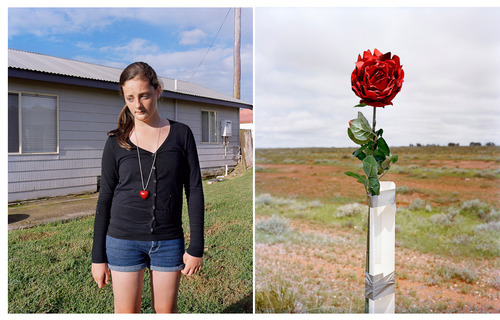
© Amy Stein & Stacy Mehrfar from 'Tall Poppy Syndrome'
Soon after this conversation I returned to Sydney. The project and road trip seemed remote until Amy got an invitation to exhibit at the Australian Center for Photography in Sydney. The Center, along with Foto Freo, a biennial photography festival in Perth, sponsored her trip to Australia in March 2010. We took the opportunity to create this series.
Amy mentioned in an earlier conversation that one thing you were looking for were differences between American and Australian cultures. Did you uncover anything that surprised you? Did your ideas of Australian culture change as you explored the land?
Amy Stein (AS): Beyond the myths and clichés from TV, cinema and commercials (Outback Steakhouse anyone?) I had very little genuine knowledge of Australia. I think that’s true for most Americans. We think of Australia as a sunny place that’s very far away and on occasion they produce a celebrity that breaks orbit from the continent and invades our movies and pop charts. I arrived in Australia confident that I knew almost nothing authentic about the culture beyond this vague notion of Tall Poppy Syndrome. The next day we packed the car and set out on our trip. All the images we made during the trip were a complete gut reaction to what we saw and experienced, so our reaction to the culture is in the pages of the book. The landscape and the people I found relaxed and friendly. Some people say that Australia has a similar feeling to America in the 50s and early 60’s when the country was at peace and had a sense of pride and optimism. The more time I spent in there the more I could relate to that. I still don’t think I know a lot about Australian culture. A month of travel through a limited area of a massive country is not enough to form real insights. Those limits of knowledge and experience are inherent in the book and an important part of the dialogue.

© Amy Stein & Stacy Mehrfar from 'Tall Poppy Syndrome'
The term, “Tall Poppy Syndrome” refers to a social phenomenon in which distinguished members of society are effectively resented by their peers because of their talents and achievements. The images in this book seem to primarily portray working class Australians and their environments. Among the portraits, many were made in a way that lends no glamour to their subjects and these people don’t seem to be among that group of tall poppies. What is to be said about them then? Should they themselves be criticized? Celebrated? Should they be met with sympathy or pity?
SM: Tall poppy syndrome is essentially about both achievers and the societal compulsion to tear them down. To capture the subtleties from the perspective of the individual and the collective we focused our attention on group dynamics in small towns. We kept asking ourselves and those we met along the way: What is the relationship between the group and the individual? How does the individual relate to his/her peers when one is expected to not “stand out from the crowd?” Do individuals seek to be celebrated? Does TPS create a society of medians? We were not interested in celebrating, criticizing, or sympathizing with Australians- we simply wanted to observe the context of the phenomenon.
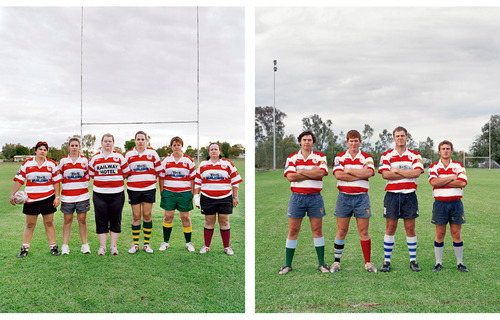
© Amy Stein & Stacy Mehrfar from 'Tall Poppy Syndrome'
Staying on the same topic, this term implies many ideas about power and prestige, and the financial gap between higher and lower classes that seems to be growing worldwide. It could even be said that the “Tall Poppy Syndrome” goes beyond Australia, as we have seen this year hundreds of Occupy Wall Street-type of protests around the globe. Did either of you take these ideas into account? Do either of you feel that this is a political book
AS: We made this work in March 2010, a bit before the first OWS protests started, but the bank and real estate crisis in the US were top of mind. One of the reasons we started this project was to explore our personal conflicts between the prevailing American invention that individual success is the highest measure of a society and the greed and apathy that mentality tends to produce. Even though we are both on the far left side of the political spectrum, we still came to the project with a very strong sense of the individual and a cast a wary eye at a society that would devalue personal expression.
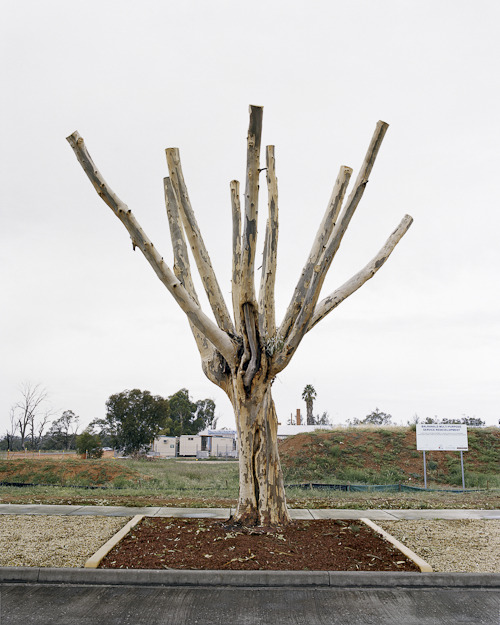
© Amy Stein & Stacy Mehrfar from 'Tall Poppy Syndrome'
As we got deeper into the collaboration we were able to let a lot of that me-first baggage go. As we met and photographed more Australians, the political realities of the world slipped to the background and the individual stories of hardiness, happiness and accomplishment became the focal point of our interest. The Australian people we met celebrated individualism in every facet of their life and culture and we began to realize that Tall Poppy Syndrome is likely a reaction to exceptionalism rather than achievement or personal expression.

© Amy Stein & Stacy Mehrfar from 'Tall Poppy Syndrome'
A large portion of this book seems to be composed of slice-of-life images, and we’re introduced to the everyday leisure and work of rural Australia. In this series we see boys out surfing, a small town civics group, rugby teams and children in class. Are these types of pictures ones you actively sought out? Or were these groups stumbled upon?
SM: A mix of both. From the beginning, Amy and I put together a shot list that we relentlessly edited and then referred to along our journey. Knowing that we couldn’t photograph the entire continent we decided on a route that would expose us to different landscapes like the coast, the country and a bit of the outback. We knew we wanted to look for certain clichés of Australian culture, particularly from an American eye, and we wanted to photograph social groups. We contacted town councils, social clubs and businesses to find the sorts of images we had in mind. We also wanted to work within the road trip tradition, so we allowed ourselves the freedom to discover images along our journey and to let our understanding of TPS evolve.

© Amy Stein & Stacy Mehrfar from 'Tall Poppy Syndrome'
A month on the road in Australia seems like once-in-a-lifetime experience. Would each of you mind recounting a story from the trip that we don’t see in the book?
SM: While researching the shot list for the trip I came upon the story of a man named Mon Mackellar. Mon is a 60-something man from Weethalle, a town in New South Wales with a population of 280. He selflessly saved a young man from a burning oil truck- he went in and pulled the man out before the firemen got to the scene. He won an Australia Day Award for this heroic act. We went to Weethalle to photograph Mon, assuming we would photograph him and get back on the road rather quickly. It was quite an emotional encounter and we ended up spending most of the day with Mon and a few of his family members. The experience was very powerful and we’re still in touch with them today. The photograph of the classroom -another item on our shot list - came about because of Mon. His grandchildren attend the school (they’re in the photograph), and he works there as a general assistant. He brought us to the school, introduced us to the staff and children. If Mon hadn’t taken us in and embraced the project, we wouldn’t have had the access to make that picture. And we wouldn’t be the proud owners of Akubras either. They came in handy in the outback.

© Amy Stein & Stacy Mehrfar from 'Tall Poppy Syndrome'
AS: The story of how we lost our intern on the fourth day of the trip is a bit of a “rip snorter” as the Aussies say. As we were planning the trip we hired a recent grad to accompany us and to help us with understanding the culture, loading film, taking notes, talking to subjects, navigating and keeping us caffeinated. She was a lovely girl but perhaps not as interested in photography as she led us to believe. We were shooting at all hours of the day, starting at first light and shooting until dusk. We were there to make pictures.
It was the beginning of the trip and we were excited and had a very tight schedule. Things were intense. We were sleeping in the same hotel room, we were together 24/7: in the car, on the side of the road, making images, eating meals together.

© Amy Stein & Stacy Mehrfar from 'Tall Poppy Syndrome'
I guess it was just too much for her. By the end of day four–after a really complicated shoot involving lights and multiple subjects–she told us she had purchased a bus ticket and was making the 12 hour trip back to Sydney that evening. This was very shocking news. We were alone on the edges of the outback. It was a real moment of confrontation for Stacy and me. We no longer had a buffer between us. Our guide, note-taker and the person who could filter through our sometimes competing opinions and approaches to making images was gone. We were hurt and stunned, but as we continued on our way, this new situation led to frank discussions about the aims of the project and the true nature of collaboration.

© Amy Stein & Stacy Mehrfar from 'Tall Poppy Syndrome'
Initially we thought losing our intern was going to be a real liability -Stacy was 7.5 months pregnant and I didn’t drive on the left side of the road- and in some ways it was much more difficult without her, but it deepened our relationship with each other, the project and our subjects.
Last but not least, what’s next for both you and Stacy over the next year, photographically or otherwise?
AS: I’m focusing on the release of this book and preparing for a show of the series with my NYC gallery ClampArt in January. I’m also back to teaching at Parsons/The New School which I’m really enjoying this fall. In my free time I’m working on an edit and sequence for my third book, 'Stranded’, which I hope will be released sometime next year and starting a new personal project about my struggle with fertility.
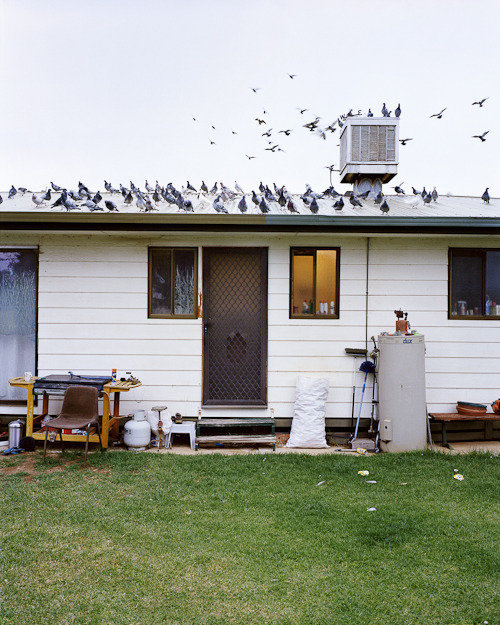
© Amy Stein & Stacy Mehrfar from 'Tall Poppy Syndrome'
SM: As Amy said, we’re working on the release of the book in the States and Australia. One very exciting event is a cross-continent lecture happening simultaneously at Apple stores in New York and Sydney. Amy will be in the New York Apple store at the same time that I am at the Apple store in Sydney (Dec 6th in NY/Dec 7th in Sydney). Apple hasn’t done this before and so we’re really looking forward to that. I recently started lecturing at the National Arts School in Sydney, which has been extremely gratifying, while at the same time I am working on a new body of work dealing with cross-cultural identity and globalization.
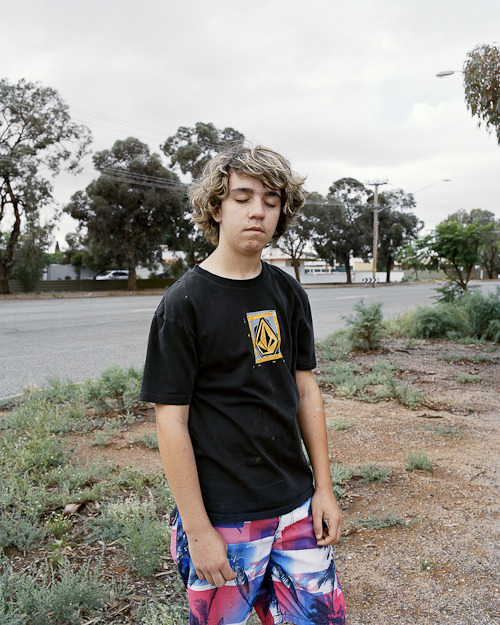
© Amy Stein & Stacy Mehrfar from 'Tall Poppy Syndrome'
Amy Stein, Biography: Amy Stein (b. 1970) is a photographer and teacher based in New York City. Her work explores our evolving isolation from community, culture and the environment. She has been exhibited nationally and internationally and her work is featured in many private and public collections such as the Philadelphia Museum of Art, the Museum of Contemporary Photography, the Nevada Museum of Art, the Nerman Museum of Contemporary Art and the George Eastman House Photography Collection. Amy was raised in Washington, DC, and Karachi, Pakistan. She holds a BS in Political Science from James Madison University and a MS in Political Science from the University of Edinburgh in Scotland. In 2006, Amy received her MFA in photography from the School of Visual Arts in New York. Stein teaches photography at Parsons The New School for Design and the School of Visual Arts in New York City. Amy is represented by Robert Koch Gallery in San Francisco and ClampArt in New York.
Stacy Arezou Mehrfar, Biography: Stacy Arezou Mehrfar (b.1977) is an American photo-based artist and educator currently residing in Sydney, Australia. Predominately working on long-term projects that explore cultural identity, her images have been exhibited in the United States, Australia, Poland and Germany. Stacy has received distinctions from the Moran Arts Foundation, the Camera Club of New York, the Center for Photography at Woodstock, Photography.Book.Now, among others. Her images are held in several public and private collections worldwide. Mehrfar teaches photography at the National Arts School in Sydney, Australia.
---
LINKS
Stacy Mehrfar
Amy Stein
United States
Australia
share this page